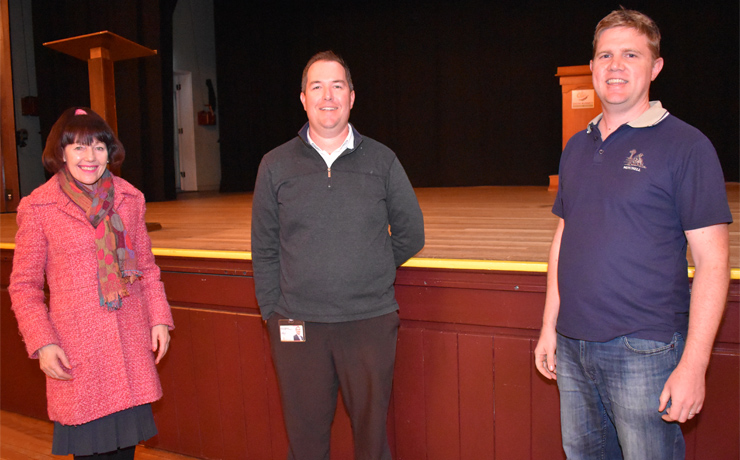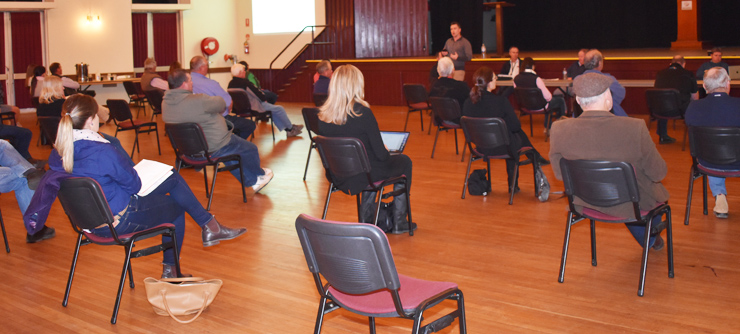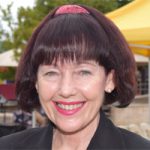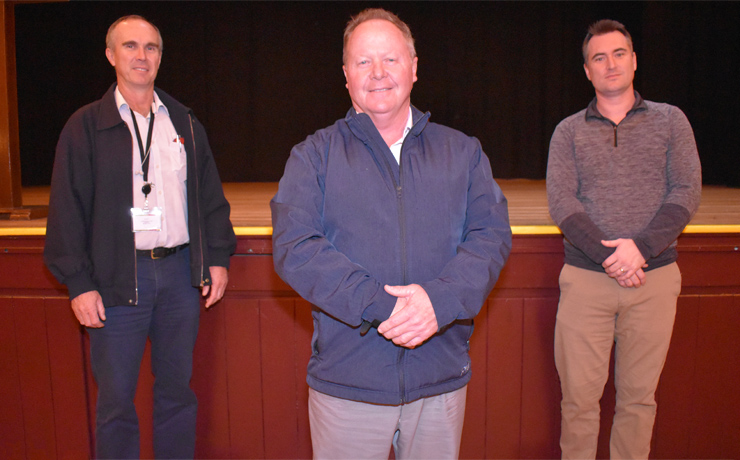
July 9, 2020
by Anne Miller
A proposal to construct a water recycling plant at Swickers’ pig abattoir in Kingaroy is the key new item on a proposed shortlist of possible future South Burnett water projects.
Swickers are heavy water users due to the nature of their business and lack of security during drought has led to the major employer approaching the South Burnett Regional Council several times in the past for assistance.
The shortlist – part of an initial strategic business case to increase agriculture production and water security in the region – was unveiled on Wednesday evening by consultants Jacobs, engaged by the South Burnett and North Burnett regional councils working in partnership with SunWater and the Department of Natural Resources, Mines and Energy.
The $2 million Burnett Water Feasibility Study was funded by a Federal Government grant.
About 45 people gathered at Kingaroy Town Hall to hear the report back by Jacobs’ economists.
Apart from the Swickers’ proposal, other items on the list have been widely discussed before:
- Barlil Weir, 8km north-west of Murgon on Barambah Creek – this was previously identified as infrastructure of significance by the Department of State Development in 2003 after being granted Federal Government approval in 2001. Estimates for its construction have varied from $2.8 million (2003) to more recent rumoured estimates of $16 million. The expected yield from this “re-regulating” weir would be about 3000ML.
- Tarong power stations to make greater use of water from Wivenhoe Dam (or “manufactured” water products), freeing up more Boondooma Dam water for urban and commercial use in Kingaroy; this would allow poorer quality water from Gordonbrook Dam, currently being used to supplement Kingaroy’s town water supply, to be converted to agricultural use. The difference in cost between Wivenhoe water and Boondooma water at present discourages this from happening.
- Greater utilisation of the Wivenhoe to Tarong pipeline for irrigation in Blackbutt, especially for avocado growers. This project has also been put forward as one of Queensland’s “top five” priority irrigation projects by the Queensland Farmers Federation, citing a recommendation from Jacobs.
- Raising the Boondooma Dam wall.
- Removing the 70,000ML cut-off rule from Boondooma Dam.
- Flood harvesting from Barambah Creek into Bjelke-Petersen Dam.
South Burnett mayor Brett Otto said some of the projects would be included in the final report, while others would remain under consideration.
However, the information gathered would help to strengthen any business case put forward for the State Government to consider when reviewing proposed irrigation investment in the region.
Jacobs principal economist Matt Bradbury provided demographic data which showed agriculture was the second largest employer in the South Burnett.
Agricultural output, though, has gone up and down over the years, reflecting whether the year had been wet or dry.
“Perhaps what we are missing is a little bit of water,” he said.
“Large areas of fertile land have no access to a reliable water source … hindering crop yields, value and diversity.”
He also identified urban water security as an issue as water restrictions needed to be imposed too frequently.
However, the area’s access to markets, via road to ports or airports – including Wellcamp – was very good as was the capacity of the electricity network to support local value-adding processing.
But he noted that socio-economic disadvantage in the South Burnett was higher than the North Burnett, Queensland or Australia.
“It is an area that would really benefit from investment,” he said.
Consultant Chris Hewitt said 22 options had initially been developed which covered the South and North Burnett regions.
Going through the shortlist of South Burnett projects (above), he said the Swickers water recycling plant was a good project “but obviously there is a cost involved”.
There were four different ways the Tarong / Wivenhoe Dam proposal could be implemented.
However, removing the 70,000ML cut-off from Boondooma was not a strong recommendation nor was raising the Boondooma Dam wall. This would be very expensive without yielding much benefit.
Jacobs completed a “multi-criteria analysis” scoring impediments, benefits and possible legal and environmental issues for each project.
This had identified the top projects: Four in the North Burnett, five in the South Burnett and one that covered both regions.
He said the next steps in the South Burnett should be:
- The development of a 25-year economic roadmap, preparing for a time when the Tarong power stations closed, ie. a significant employer leaving and a significant water resource becoming available.
- The development of an urban water strategy.
- Progression of the Blackbutt irrigation project – which was ready to action, but won’t be easy to achieve.
- Assessment of Gordonbrook Dam – what is its role to be in the future?
- Practical assessment of the Barlil Weir project before the development of a detailed business case.
The water forum followed a consultation process by Jacobs which began last November but was derailed when COVID-19 restrictions stopped some public meetings from being held.
However, the consultants met with a number of individual water users and water user groups as well as reviewing previous studies.
This is ongoing with water users still invited to contact the South Burnett Regional Council to make arrangements to meet with the Jacobs team.
Concurrently, Jacobs has also been working with SunWater on a long-term water blueprint for the region.
- External link: Strategic Business Case (13.7Mb PDF)
[UPDATED August 25, 2020 with correction. An earlier version of this report stated that Jacobs was also working on a $1.5 million study to assess a possible Coalstoun Lakes irrigation pipeline from Paradise Dam. However, funding for this project has not yet been signed off so no contract for the work has been awarded.]
Related articles:
- Water Study Highlights Blackbutt
- Meeting To Distill Water Options
- Burnett Water Study Begins
- Extra $1.5m For Water Study
- Petition Demands Dam Reports
- Push For Dam Inquiry Fails
- Water Releases Begin From Dam
- LNP MPs Demand Dam Answers
- LNP Demands Inquiry Into Dam
- Paradise Dam ‘A Golden Opportunity’
- Department To Lead Water Study
- Water Infrastructure Study Inches Ahead
- Mayor Calls Water Meeting
- Consultant Tipped For Water Project
- Great Ideas … Just Add Water
- Water Meeting On Thursday
- Council To Consult Widely On Water Projects
- $2m Study To Improve Irrigation
- Council Ideas Receive Funding
- QFF Welcomes Water Study
